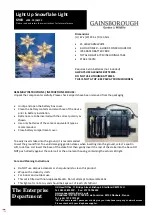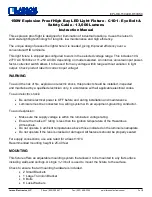
4. Gas Control Module (Enhanced)
54
IFU for Infinite 200 PRO No. 30052730 Rev. No. 1.6
2016-04
4.2
Gas Control Module Features
The gas control module enhanced (GCM
TM
) offers a comprehensive solution for a
variety of cell-based applications for the Infinite 200 PRO multimode reader.
Two integrated gas inlets allow the external control of CO
2
and O
2
to help
maintain stable culture conditions and improve cell growth. Carbon dioxide
concentration is regulated by an inflow of CO
2
gas, whereas oxygen reduction is
achieved by supplying N
2
gas.
The GCM makes the Infinite 200 PRO ideally suited for in vitro studies of
eukaryotic cell lines or extends the usage of the instrument for microplate
investigations using anaerobe or facultative anaerobic bacteria.
4.2.1
Gas Control Module Configurations
Settings:
The O
2
concentration can be set in the range from 0.1 – 21 vol. %.
The O
2
control range is 0.1 – 21 vol. %.
The CO
2
concentration can be set in the range from 0 – 10 vol. %.
The CO
2
control range is 0 – 10vol. %.
The Accuracy of measured O
2
concentration is +/- 0.9 vol. %.
The Accuracy of measured CO
2
concentration is +/- 1 vol. %.
The GCM is available in two configurations:
•
‘CO2 and O2’ configuration:
CO
2
and/or O
2
concentrations can be
regulated inside the reader chamber.
•
‘CO2’ configuration:
CO
2
concentration can be regulated inside the reader
chamber
‘CO2’ and ‘O2’ Configuration
There are four gas control modes available for the GCM enhanced with
‘CO2 and O2’ configuration
:
•
Carbon Dioxide Mode:
In CO2 Mode, CO
2
gas is introduced into the
instrument (plate carrier compartment/reader chamber).
•
Oxygen Mode:
In O2 Mode, N2 gas is introduced to reduce the oxygen gas
concentration inside the instrument to below ambient air levels.
•
DUAL Mode:
In DUAL Mode, the flow of CO
2
and N
2
gas is controlled
automatically by opening or closing the valve while monitoring both
concentrations (vol. %) inside the instrument.
•
Manual Mode:
In Manual Mode, the flow of CO
2
and/or N
2
gas is controlled
by opening or closing the valve manually while monitoring both
concentrations (vol. %) inside the instrument.
















































